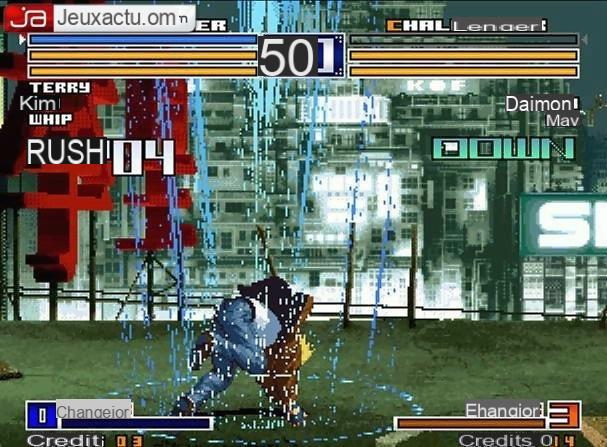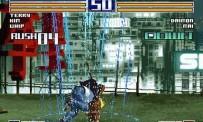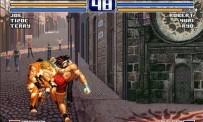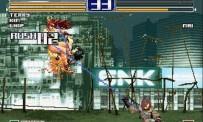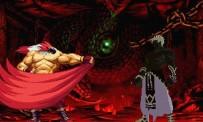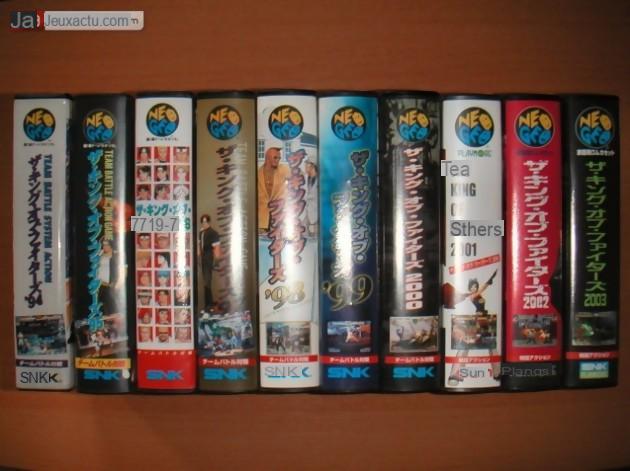 After 14 years of good and loyal service, the Neo Geo is about to bow out. Born one fine morning in 1990, the so-called Rolls Royce of consoles offered real arcade games at home at the time. Same graphic quality, same soundtrack and above all identical handling to arcade terminals thanks to its famous almost unalterable sticks. The Neo Geo was therefore the must-have console for any self-respecting fan of racy 2D fighting. While the 16-bit war between the Super Nes and the Megadrive was raging, SNK was attacking any other audience, those capable of spending lavishly and affording games at prices around 1500F in the first place (approximately €230). Over the years, the price of these monstrous cartridges amplified to now reach an average of 350 € (2300F). Despite the weight of the years, the public always responds and the release of a new cartridge is a major event. And this is exactly the case for this 2003 opus with surprising and above all unexpected qualities.
After 14 years of good and loyal service, the Neo Geo is about to bow out. Born one fine morning in 1990, the so-called Rolls Royce of consoles offered real arcade games at home at the time. Same graphic quality, same soundtrack and above all identical handling to arcade terminals thanks to its famous almost unalterable sticks. The Neo Geo was therefore the must-have console for any self-respecting fan of racy 2D fighting. While the 16-bit war between the Super Nes and the Megadrive was raging, SNK was attacking any other audience, those capable of spending lavishly and affording games at prices around 1500F in the first place (approximately €230). Over the years, the price of these monstrous cartridges amplified to now reach an average of 350 € (2300F). Despite the weight of the years, the public always responds and the release of a new cartridge is a major event. And this is exactly the case for this 2003 opus with surprising and above all unexpected qualities.
Playmore has finally woken up!
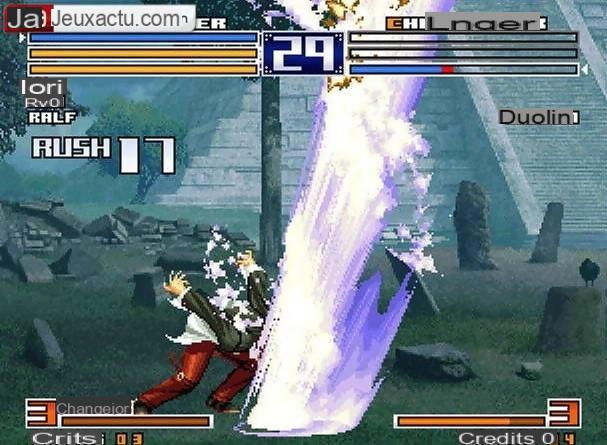 Let's not cut corners, since Eolith and then Playmore took over all SNK titles, the quality of the games has dropped considerably. Proof is with the shameful performance of KOF 2001 and the very disappointing SNK VS Capcom CHAOS. Characters singularly lacking in charisma, amputated special moves, completely soft knee gameplay, downgraded graphics and an awful soundtrack. In short, we had almost come to wonder if Playmore, was not throwing a big jump of water on the little fire that remained. The fun was seriously lacking and even though the SNK name continued to live on through Playmore, things have since changed a lot. Aware of these relative failures, the firm has therefore decided to roll up its sleeves to the shoulders to close the series as it should be before the Neo Geo takes its deserved retirement.
Let's not cut corners, since Eolith and then Playmore took over all SNK titles, the quality of the games has dropped considerably. Proof is with the shameful performance of KOF 2001 and the very disappointing SNK VS Capcom CHAOS. Characters singularly lacking in charisma, amputated special moves, completely soft knee gameplay, downgraded graphics and an awful soundtrack. In short, we had almost come to wonder if Playmore, was not throwing a big jump of water on the little fire that remained. The fun was seriously lacking and even though the SNK name continued to live on through Playmore, things have since changed a lot. Aware of these relative failures, the firm has therefore decided to roll up its sleeves to the shoulders to close the series as it should be before the Neo Geo takes its deserved retirement.
The Newcomers
 The first glaring finding is from the character selection screen. The character design has finally returned to that of the good old days and the belligerents have at first glance a class of the neatest. On the menu of the festivities, there are no less than 32 characters divided into teams of 3 fighters, with the exception of the two enemy brothers that are Kyo Kusanagi (who still wears a new outfit) and Iori Yagami, each going it alone. SNK Playmore seems to have given up on the striker system and that's good! The Hero Team is now represented by the presence of Ash Crimson (follower of green flames), Duo Lon (speed is his main asset) and Shen Woo (agile with his devastating fists). The Fatal Fury Team dropped Andy Bogard to the chagrin of the players to make way for Tizok, an eagle-headed wrestler straight from Garou: Mark of The Wolves. The Art of Fighting team stays true to itself with a brand new (rather dud) sprite for Robert Garcia. Good news for the Korean Team, Choi Bounge has been replaced by the excellent taekwondo player Jhun Hoon. We rejoice!
The first glaring finding is from the character selection screen. The character design has finally returned to that of the good old days and the belligerents have at first glance a class of the neatest. On the menu of the festivities, there are no less than 32 characters divided into teams of 3 fighters, with the exception of the two enemy brothers that are Kyo Kusanagi (who still wears a new outfit) and Iori Yagami, each going it alone. SNK Playmore seems to have given up on the striker system and that's good! The Hero Team is now represented by the presence of Ash Crimson (follower of green flames), Duo Lon (speed is his main asset) and Shen Woo (agile with his devastating fists). The Fatal Fury Team dropped Andy Bogard to the chagrin of the players to make way for Tizok, an eagle-headed wrestler straight from Garou: Mark of The Wolves. The Art of Fighting team stays true to itself with a brand new (rather dud) sprite for Robert Garcia. Good news for the Korean Team, Choi Bounge has been replaced by the excellent taekwondo player Jhun Hoon. We rejoice!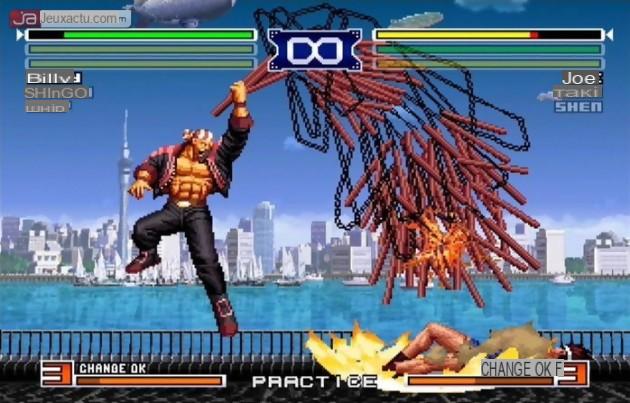
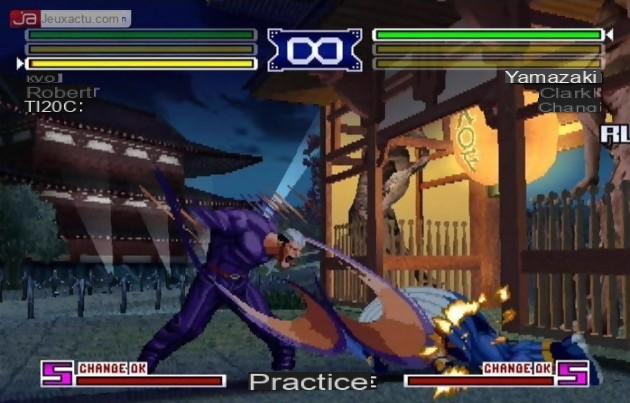 No change for the Ikari Warriors team nor for that of K '. On the other hand, two teams of girls are now appearing. That of mature women (King, Mai Shiranui and Blue Mary) and that of younger girls, led by Athena Asamiya who saw her teammates from the Psycho Soldiers Team pushed to the bench. The latter is now supported by Hinako, our female Edmond Honda and Malin, a newcomer who handles the yo-yo like no one else. The Outlaw Team signs its return and the trio is now made up of Gato (from Mark of The Wolves), Billy Kane and Ryuji Yamasaki who have both undergone a slight clothing facelift. And finally to finish, we find Benimaru Nikaido as leader of the Japanese team with Shingo Yabuki and Goro Daimon at his side. You should also know that there are five other hidden characters (Kusanagi, Chizuru Kagura and her twin sister Maki, Adel the innocuous son of Rugal and Mukai the Big Boss of the game), all playable provided you execute a code at the character selection screen. Of course, you have the choice to compose your own team but if you want to see the respective endings of each of them, it is imperative to choose the original trio. Now that the presentations have been made, let's enter the arena to see if this brand new combat system will be able to breathe new life into the saga.
No change for the Ikari Warriors team nor for that of K '. On the other hand, two teams of girls are now appearing. That of mature women (King, Mai Shiranui and Blue Mary) and that of younger girls, led by Athena Asamiya who saw her teammates from the Psycho Soldiers Team pushed to the bench. The latter is now supported by Hinako, our female Edmond Honda and Malin, a newcomer who handles the yo-yo like no one else. The Outlaw Team signs its return and the trio is now made up of Gato (from Mark of The Wolves), Billy Kane and Ryuji Yamasaki who have both undergone a slight clothing facelift. And finally to finish, we find Benimaru Nikaido as leader of the Japanese team with Shingo Yabuki and Goro Daimon at his side. You should also know that there are five other hidden characters (Kusanagi, Chizuru Kagura and her twin sister Maki, Adel the innocuous son of Rugal and Mukai the Big Boss of the game), all playable provided you execute a code at the character selection screen. Of course, you have the choice to compose your own team but if you want to see the respective endings of each of them, it is imperative to choose the original trio. Now that the presentations have been made, let's enter the arena to see if this brand new combat system will be able to breathe new life into the saga.
The ultimate combat system?
 If since the very first KOF, there has always been a leader in each team, the latter was never highlighted until then. It is now done with the arrival of KOF 2003 which therefore offers to select your team leader. Unfortunately, in Story mode, it is impossible for you to change the latter and this is the big criticism that can be made with respect to this new combat system. Either way, every leader benefits from what's called the Leader Desperation Move. In other words, a third ultimate fury that will eat you two bars of power. Since their appearance in Fatal Fury 2, furies have evolved considerably and it is now impossible to design a 2D fighting game without their presence. In KOF 2003, you start the fights with three power gauges and as many energy bars, each corresponding to your three characters. Another novelty and not the least is the integration of victory in a single round. Until then, the clashes took place in three winning sets with, each time, a presentation of the newcomer. KOF 2003 revolutionizes the system (it's not new, I grant you, but hey…) by making the next fighter appear directly. Your opponent's life bar does not move an inch and gives you every chance to knock him out. Casually, this system that we may find harmless on paper turns out to be really effective, accelerating the fights which no longer lose an ounce of their nervousness. At any time, you can switch teammates by pressing either B+C or C+D when Change OK allows it. A bit like a Rage of The Dragons, it will be possible to execute what is called a Tag attack. This consists of hitting your opponent just before switching characters. This allows the next character to arrive by giving him a good tatane blow in the face, which should give you time to chain a devastating combo. The fights thus gain more technicality, giving free rein to your imagination in terms of combo sequences. A real treat !
If since the very first KOF, there has always been a leader in each team, the latter was never highlighted until then. It is now done with the arrival of KOF 2003 which therefore offers to select your team leader. Unfortunately, in Story mode, it is impossible for you to change the latter and this is the big criticism that can be made with respect to this new combat system. Either way, every leader benefits from what's called the Leader Desperation Move. In other words, a third ultimate fury that will eat you two bars of power. Since their appearance in Fatal Fury 2, furies have evolved considerably and it is now impossible to design a 2D fighting game without their presence. In KOF 2003, you start the fights with three power gauges and as many energy bars, each corresponding to your three characters. Another novelty and not the least is the integration of victory in a single round. Until then, the clashes took place in three winning sets with, each time, a presentation of the newcomer. KOF 2003 revolutionizes the system (it's not new, I grant you, but hey…) by making the next fighter appear directly. Your opponent's life bar does not move an inch and gives you every chance to knock him out. Casually, this system that we may find harmless on paper turns out to be really effective, accelerating the fights which no longer lose an ounce of their nervousness. At any time, you can switch teammates by pressing either B+C or C+D when Change OK allows it. A bit like a Rage of The Dragons, it will be possible to execute what is called a Tag attack. This consists of hitting your opponent just before switching characters. This allows the next character to arrive by giving him a good tatane blow in the face, which should give you time to chain a devastating combo. The fights thus gain more technicality, giving free rein to your imagination in terms of combo sequences. A real treat !
As good as a KOF '98?
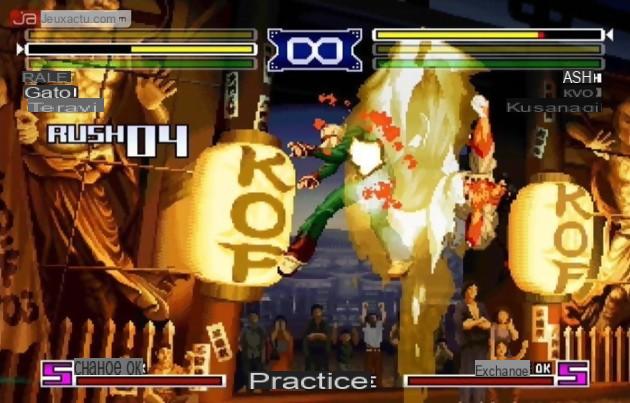 No need to procrastinate lines during. Although KOF 2003 is lodged in the pantheon of the best episodes of the series, the latter does not yet reach the rare quality of a KOF '98. The decorations, however neat they may be, still lack originality. The observation is the same for the soundtrack which does not yet offer music as punchy as the 98 edition. We also regret the impacts of blows that are a little too discreet and clearly lacking in power. Graphically, KOF 2003 is doing very well with colorful sets that are all different from each other, all supported by very successful lighting effects (superb Buster Wolf by Terry Bogard). Even if many sprites have been retouched, others, on the other hand, are really starting to show the weight of the years, with completely mechanical animations that deserve a little makeover (Leona and Benimaru for example). Despite everything, the set remains in good order and SNK Playmore finally seems to have found the right path. The bad times of KOF 2001 seem to have been forgotten and we can finally congratulate the development teams for having provided high quality work.
No need to procrastinate lines during. Although KOF 2003 is lodged in the pantheon of the best episodes of the series, the latter does not yet reach the rare quality of a KOF '98. The decorations, however neat they may be, still lack originality. The observation is the same for the soundtrack which does not yet offer music as punchy as the 98 edition. We also regret the impacts of blows that are a little too discreet and clearly lacking in power. Graphically, KOF 2003 is doing very well with colorful sets that are all different from each other, all supported by very successful lighting effects (superb Buster Wolf by Terry Bogard). Even if many sprites have been retouched, others, on the other hand, are really starting to show the weight of the years, with completely mechanical animations that deserve a little makeover (Leona and Benimaru for example). Despite everything, the set remains in good order and SNK Playmore finally seems to have found the right path. The bad times of KOF 2001 seem to have been forgotten and we can finally congratulate the development teams for having provided high quality work.
